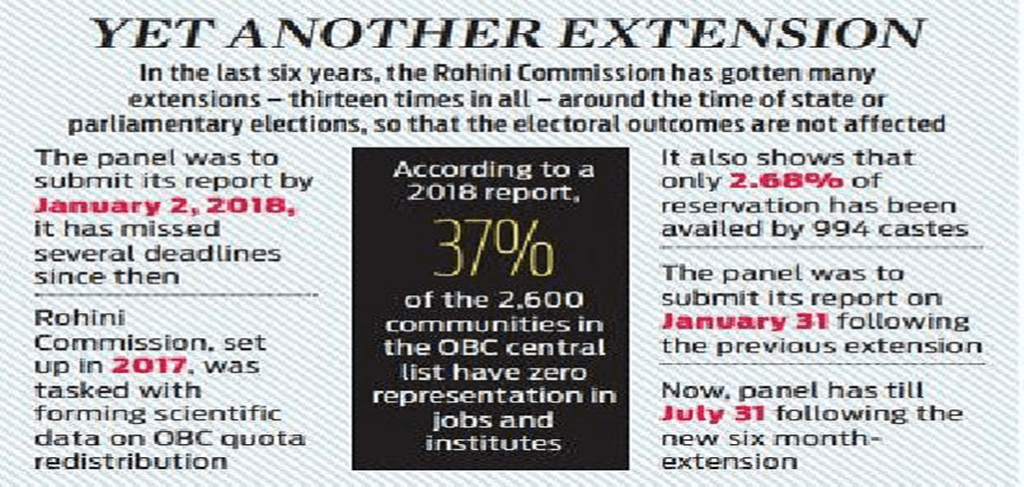Daily Current Affairs : 2-August-2023
The Rohini Commission report, recently submitted to the President, aimed to address the distortions in the affirmative action policy, particularly the reservation system for Other Backward Classes (OBCs) in India. The commission, headed by Justice G Rohini, was appointed in October 2017 and was given multiple extensions to its tenure. The need for sub-categorisation of OBCs arose due to the perception that only a few privileged castes within the OBC community were benefiting from the 27% reservation, leading to calls for equitable distribution.
Understanding the Need for Sub-Categorisation:
- OBCs are entitled to a 27% reservation in central government jobs and educational institutions.
- The Central List of OBCs consists of over 2,600 entries, but it is believed that a handful of prosperous communities are reaping the majority of reservation benefits, leaving others behind.
- To ensure a fair and balanced distribution of reservation benefits, there is a demand for a “sub-categorisation” of OBC quotas within the overall 27% quota.
Exploring the Terms of Reference of the Rohini Commission:
The commission’s original mandate was to:
- Examine the distribution of reservation benefits among different OBC castes or communities listed in the Central List.
- Develop a scientific approach to sub-categorise OBCs based on mechanism, criteria, norms, and parameters.
- Identify and classify respective castes or communities into their specific sub-categories. The commission’s tenure, initially set for 12 weeks, was extended multiple times. In 2020, an additional term was included:
- Review and rectify any repetitions, ambiguities, inconsistencies, or errors in the Central List of OBCs.
Analysis of the Reservation Benefits:
In 2018, the commission analyzed data from the previous five years, which showed that:
- 97% of central government jobs and educational seats reserved for OBCs were secured by only 25% of OBC castes.
- Out of these, a mere 10 OBC communities secured 24.95% of these jobs and seats.
- Shockingly, 37% of OBC communities had zero representation in both jobs and educational institutions.
- Additionally, 994 OBC sub-castes accounted for only 2.68% representation in recruitments and admissions.
Challenges in the Analysis:
One major limitation of this analysis was the lack of updated population data. This hindered the commission’s ability to accurately assess the actual representation of various OBC communities and sub-castes in relation to their population size.

Important Points:
- The Rohini Commission report examined the sub-categorisation of Other Backward Classes (OBCs) in India.
- The commission, headed by Justice G Rohini, was appointed in October 2017 and received several extensions to its tenure.
- The need for sub-categorisation arose due to the perception that only a few affluent OBC communities were benefiting from the 27% reservation, leaving others with limited access to opportunities.
- The commission’s terms of reference included examining the distribution of reservation benefits, developing a scientific approach for sub-categorisation, and identifying specific sub-categories within OBCs.
- An additional term was later added to review and rectify any errors or inconsistencies in the Central List of OBCs.
- The analysis of reservation benefits revealed that 97% of jobs and seats reserved for OBCs were secured by only 25% of OBC castes, with 24.95% of these going to just 10 OBC communities.
- Shockingly, 37% of OBC communities had zero representation in both jobs and educational institutions.
- The limited availability of updated population data posed a challenge to accurately assess the representation of various OBC communities and sub-castes.
- The report aims to create a more inclusive and fair reservation policy by ensuring equitable distribution of benefits and preventing the monopolization of advantages by a few affluent OBC castes
Why In News
The Rohini Commission report, which was established to investigate the sub-categorisation of Other Backward Classes (OBCs), was recently submitted to the President, shedding light on potential measures to ensure equitable representation and targeted welfare policies for various OBC communities.The comprehensive findings of the Rohini Commission report are expected to pave the way for more nuanced and tailored affirmative action initiatives, fostering greater inclusivity and empowering marginalized OBC groups across the nation.
MCQs about The Rohini Commission Report
-
What was the main purpose of setting up the Rohini Commission?
A. To examine the distribution of benefits under the SC/ST reservation.
B. To study the effectiveness of the 10% reservation for Economically Weaker Sections (EWS).
C. To analyze the sub-categorisation of Other Backward Classes (OBCs) reservation.
D. To investigate corruption in the implementation of the reservation policy.
-
Why was there a need for sub-categorisation of OBCs?
A. To increase the overall reservation quota for OBCs.
B. To ensure the reservation benefits are equally distributed among all OBC communities.
C. To remove reservation benefits for affluent OBC communities.
D. To exclude certain OBC communities from the reservation policy.
-
What additional term was added to the Rohini Commission’s terms of reference in 2020?
A. Reviewing the implementation of the 27% reservation for OBCs.
B. Rectifying any errors in the 10% reservation for Economically Weaker Sections (EWS).
C. Suggesting corrective measures for SC/ST reservation.
D. Recommending correction of errors in the Central List of OBCs.
-
What was one of the limitations of the analysis conducted by the Rohini Commission?
A. The commission’s tenure was too short.
B. The absence of data on the number of OBC communities.
C. The lack of representation for SC/ST communities.
D. The unavailability of updated population data.
Boost up your confidence by appearing our Weekly Current Affairs Multiple Choice Questions
![]()


